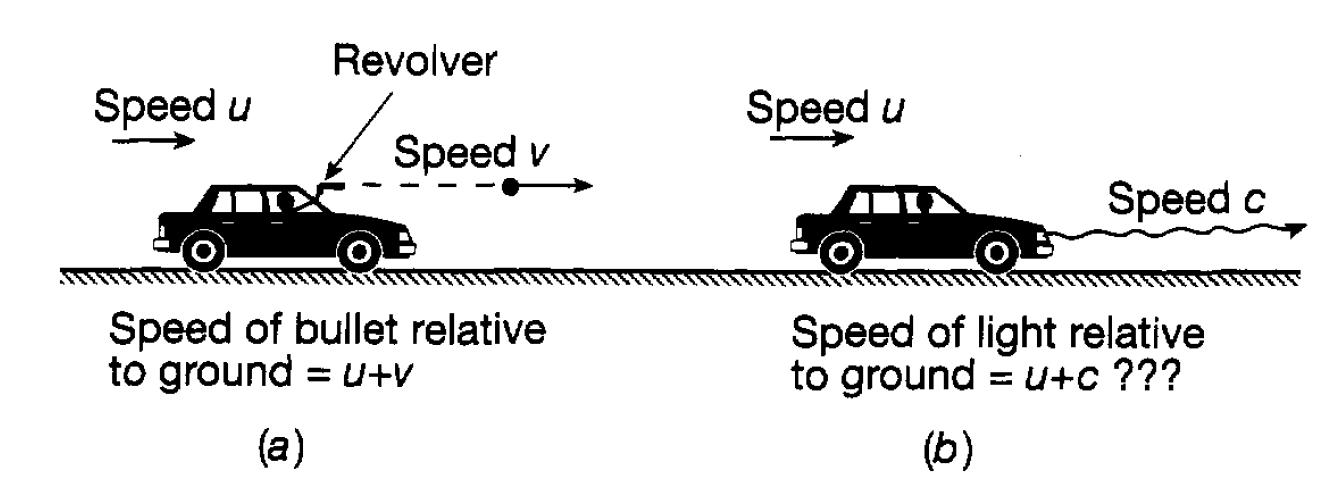
What is Relativity?
 المؤلف:
Roger J Blin-Stoyle, FRS
المؤلف:
Roger J Blin-Stoyle, FRS
 المصدر:
Physics of Particles, Matter and the Universe
المصدر:
Physics of Particles, Matter and the Universe
 الجزء والصفحة:
p 103
الجزء والصفحة:
p 103
 24-5-2016
24-5-2016
 1966
1966
On reflection it will be recognized that the physical ideas and phenomena discussed in the previous chapters have essentially been concerned with the behaviour of moving pieces of matter electrons, atoms, molecules and the way these movements account for the properties of bulk matter. Both classical mechanics and quantum mechanics have been used to specify and understand this behaviour and in all situations the speeds of the various pieces of matter have been relatively small compared with the one high speed we have encountered, namely the speed of light (c = 2.998 ×108ms-1. At this juncture it should be recognized that we can only discuss speed in a relative sense. When we speak of travelling at 100 km h-1 along a motorway, this speed is measured relative to the motorway. However, the motorway itself is moving since it is fixed to the surface of the earth which is rotating, whilst the earth itself is travelling at high speed in orbit about the sun. In other words we discuss the car's motion in terms of a notional two dimensional (left right and forward backward) frame of reference and, in the above example, this frame is, as it were, fixed to the motorway. Not all frames of reference are appropriate. For example, in discussing the general motion of everyday objects around us it is natural to use a three dimensional (left right, forward-backwards, up down) frame notionally fixed to the surface, of the earth. However, in studying the motion of planets about the sun, because of the earth's own orbital motion, the motion of other planets would appear to be highly complicated if referred to a

Figure 1.1: A two dimensional frame of reference.
frame fixed to the earth. Here it would be much more appropriate to use a frame fixed to the sun and distant stars. With reference to such a frame all planetary motion would be simple orbits and be readily accountable for in terms of Newton’s Laws of Motion and the force of gravity. In order to understand physical processes it is important to use what are known as inertial frames of reference. These are frames of reference such that a free particle subject to no force always moves in a straight line with uniform speed (which can, of course, be zero) it obeys Newton’s First Law of Motion. A frame based on distant stars is a very good approximation to such a frame and, for most practical purposes, a frame fixed to the earth is satisfactory for studying earth-bound processes; the rotation of the earth and its movement about the sun only lead to very small corrections. It is our general experience in everyday life that physical behaviour is the same in two frames of reference which are travelling at a uniform speed relative to one another. Physical processes in a train travelling at a steady speed are exactly the same as when the train is stationary. Of course absolutely steady travel is not possible and there are lurches and vibrations which disturb these processes. However, in a perfect train with a perfect track you could in principle clearly play a satisfactory game of billiards. This would not be so in a train that was accelerating or decelerating; uniform speed is essential. In other words it then might be conjectured that physical laws, both classical and quantum, are the same in all inertial frames of reference which are moving at a uniform speed with respect to each other. There is one problem, however, and that concerns the speed of light, That it has a unique value, given above, is part and parcel of the theory of electromagnetism formulated by Maxwell. This means that its speed should be the same with respect to all inertial frames of reference. However, our experience is that if, for example, you are travelling in a car at a uniform speed and shoot a bullet forward then, relative to the ground the bullet’s speed will have been enhanced by the speed of the car (figure 1.2(a)). Similarly, when the car headlights are switched on, the speed of the light emitted relative to the ground should also be enhanced (figure 1.2(b)). That is, the speed of light would appear to be higher in the inertial frame fixed to the ground than in the frame fixed to the car in contradiction to the conjecture of the last paragraph. It was faced with this contradiction that Einstein in 1905 formulated his special theory of relativity which removed it. This theory is essentially embodied in two postulates both of which have already been foreshadowed.
1. All the laws of physics are exactly the same in all inertial frames of reference.
2. The speed of light in empty space is the same in all inertial frames of reference.

Figure 1.2 (a) A bullet shot from a car; (b) light emitted from a car.
The implications of this theory are profound and far reaching. They will be discussed in the next few sections.
 الاكثر قراءة في مواضيع عامة في النظرية النسبية
الاكثر قراءة في مواضيع عامة في النظرية النسبية
 اخر الاخبار
اخر الاخبار
اخبار العتبة العباسية المقدسة


